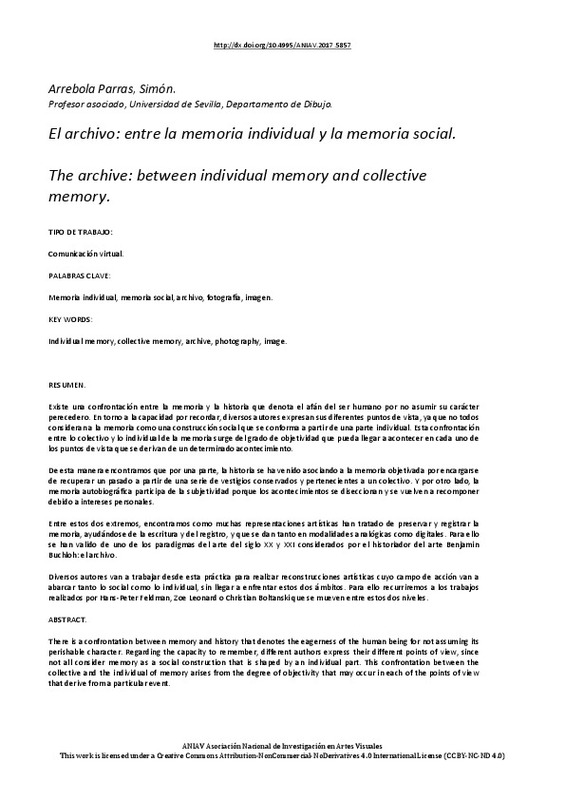JavaScript is disabled for your browser. Some features of this site may not work without it.
Buscar en RiuNet
Listar
Mi cuenta
Estadísticas
Ayuda RiuNet
Admin. UPV
El archivo: entre la memoria individual y la memoria social
Mostrar el registro sencillo del ítem
Ficheros en el ítem
| dc.contributor.author | Arrebola Parras, Simón
|
es_ES |
| dc.date.accessioned | 2018-09-03T11:59:02Z | |
| dc.date.available | 2018-09-03T11:59:02Z | |
| dc.date.issued | 2017-10-23 | |
| dc.identifier.isbn | 9788490485736 | |
| dc.identifier.uri | http://hdl.handle.net/10251/106467 | |
| dc.description.abstract | [EN] There is a confrontation between memory and history that denotes the eagerness of the human being for not assuming its perishable character. Regarding the capacity to remember, different authors express their different points of view, since not all consider memory as a social construction that is shaped by an individual part. This confrontation between the collective and the individual of memory arises from the degree of objectivity that may occur in each of the points of view that derive from a particular event. In this way, we find that on the one hand, history has been associating with the memory objectified by taking charge of recovering a past from a series of vestiges preserved and belonging to a collective. And on the other hand, autobiographical memory participates in subjectivity because events are dissected and recomposed because of personal interests. Between these two extremes, we find how many artistic representations have tried to preserve and record memory, aided by writing and recording, and which occur in both analog and digital modalities. For this they have used one of the paradigms of 20th and 21st century art considered by the art historian Benjamin Buchloh: the archive. Various authors will work from this practice to perform artistic reconstructions whose field of action will cover both the social and the individual, without getting to face these two areas. To do this we will use the work done by Hans_Peter Feldman, Zoe Leonard or Christian Boltanski who move between these two levels. | es_ES |
| dc.description.abstract | [ES] Existe una confrontación entre la memoria y la historia que denota el afán del ser humano por no asumir su carácter perecedero. En torno a la capacidad por recordar, diversos autores expresan sus diferentes puntos de vista, ya que no todos consideran a la memoria como una construcción social que se conforma a partir de una parte individual. Esta confrontación entre lo colectivo y lo individual de la memoria surge del grado de objetividad que pueda llegar a acontecer en cada uno de los puntos de vista que se derivan de un determinado acontecimiento. De esta manera encontramos que por una parte, la historia se ha venido asociando a la memoria objetivada por encargarse de recuperar un pasado a partir de una serie de vestigios conservados y pertenecientes a un colectivo. Y por otro lado, la memoria autobiográfica participa de la subjetividad porque los acontecimientos se diseccionan y se vuelven a recomponer debido a intereses personales. Entre estos dos extremos, encontramos como muchas representaciones artísticas han tratado de preservar y registrar la memoria, ayudándose de la escritura y del registro, y que se dan tanto en modalidades analógicas como digitales. Para ello se han valido de uno de los paradigmas del arte del siglo XX y XXI considerados por el historiador del arte Benjamin Buchloh: el archivo. Diversos autores van a trabajar desde esta práctica para realizar reconstrucciones artísticas cuyo campo de acción van a abarcar tanto lo social como lo individual, sin llegar a enfrentar estos dos ámbitos. Para ello recurriremos a los trabajos realizados por Hans-Peter Feldman, Zoe Leonard o Christian Boltanski que se mueven entre estos dos niveles. | es_ES |
| dc.format.extent | 5 | es_ES |
| dc.language | Español | es_ES |
| dc.publisher | Editorial Universitat Politècnica de València | es_ES |
| dc.relation.ispartof | Glocal [codificar, mediar, transformar, vivir] III Congreso Internacional de Investigación en Artes Visuales | es_ES |
| dc.rights | Reconocimiento - No comercial - Sin obra derivada (by-nc-nd) | es_ES |
| dc.subject | Memoria individual | es_ES |
| dc.subject | Memoria social | es_ES |
| dc.subject | Archivo | es_ES |
| dc.subject | Fotografía | es_ES |
| dc.subject | Imagen | es_ES |
| dc.subject | Individual memory | es_ES |
| dc.subject | Collective memory | es_ES |
| dc.subject | Archive | es_ES |
| dc.subject | Photographie | es_ES |
| dc.subject | Image | es_ES |
| dc.title | El archivo: entre la memoria individual y la memoria social | es_ES |
| dc.title.alternative | The archive: between individual memory and collective memory | es_ES |
| dc.type | Capítulo de libro | es_ES |
| dc.type | Comunicación en congreso | es_ES |
| dc.identifier.doi | 10.4995/ANIAV.2017.5857 | |
| dc.rights.accessRights | Abierto | es_ES |
| dc.description.bibliographicCitation | Arrebola Parras, S. (2017). El archivo: entre la memoria individual y la memoria social. En Glocal [codificar, mediar, transformar, vivir] III Congreso Internacional de Investigación en Artes Visuales. Editorial Universitat Politècnica de València. 746-750. https://doi.org/10.4995/ANIAV.2017.5857 | es_ES |
| dc.description.accrualMethod | OCS | es_ES |
| dc.relation.conferencename | III Congreso Internacional de Investigación en Artes Visuales :: ANIAV 2017 :: GLOCAL | es_ES |
| dc.relation.conferencedate | Julio 06-07,2017 | es_ES |
| dc.relation.conferenceplace | Valencia, Spain | es_ES |
| dc.relation.publisherversion | http://ocs.editorial.upv.es/index.php/ANIAV/ANIAV2017/paper/view/5857 | es_ES |
| dc.description.upvformatpinicio | 746 | es_ES |
| dc.description.upvformatpfin | 750 | es_ES |
| dc.type.version | info:eu-repo/semantics/publishedVersion | es_ES |
| dc.relation.pasarela | OCS\5857 | es_ES |








